Article contents
Applying the latest microscopy techniques to studyphase transformations at rail surfaces
Published online by Cambridge University Press: 21 October 2006
Abstract
Cementite decomposition leading to the formation of the whiteetching layer (WEL) on the surface of rail tracks was investigated byelectron energy loss spectroscopy (EELS) in the TEM and by threedimensionalatom probe (3D-AP). It is shown that the carbonconcentration inside cementite laths undergoing severe plasticdeformation in the transition zone between the pearlitic substrateand the WEL remains stoechiometric. However there exists a boundarylayer at the ferrite/cementite interface where the carbon compositiondecreases, indicating that decomposition is an interfacialphenomenon. Carbon atoms diffuse into the ferrite and segregatealong structural defects leading to a heterogeneous supersaturatedcomposition in the white etching layer.
- Type
- Research Article
- Information
- Metallurgical Research & Technology , Volume 103 , Issue 10: AciérieLaminageMétallurgie structurale , October 2006 , pp. 458 - 464
- Copyright
- © La Revue de Métallurgie, 2006
- 1
- Cited by


